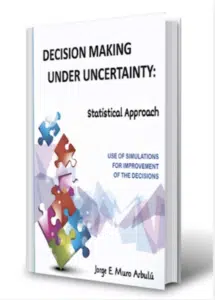
- Jorge E. Muro Arbulú (Oct 2019), “Toma de decisiones bajo incertidumbre: Enfoque estadístico. Uso de simulaciones para la mejora de las decisiones”, ISBN 978-612-00-4440-7. 594 pages.
- (Title translation: Decision making under uncertainty: A statistical approach. Use of simulations to improve decisions.)
In recent years there has been an increasing realization by managers and decision makers that quantitative methods can and should play an integral part in strategic and collaborative decision making. I encounter many people aspiring to incorporate “data-driven decision making” methods into their organization’s culture, as well as people aspiring to the even more enlightened level of “model-driven decision making.” There is mounting evidence that these approaches help decision makers improve their problem understanding, improve decision quality, and facilitate collaboration between stakeholders. You probably know this, but your challenge now is how do you acquire these skills? Dr. Muro Arbulú’s book teaches these new skills head-on in a highly accessible, hands-on, practical and comprehensive presentation. The book is beautifully produced, and I found it quite fun to read.
One of the many things I really like about the book is its focus on core skills that other textbooks usually overlook or don’t emphasize. Proficiency in quantitative methods is not about advanced mathematics, statistics, or computer science; although, most other textbooks tend to leave me with that impression. The most important core skills involve breaking down real-life situations into well-defined variables and influences, expressing belief as probability, and knowing how to apply specific types of analyses in pragmatic situations. Advanced “quants” often take these skills for granted, but they are the deepest and often most difficult skills that the student needs to master. The book emphases these deeper skills as it uses concrete examples and exercises to teach you how to build a model as an influence diagram and to use multidimensional arrays to capture data complexity without increasing model complexity. As you read along and do the exercises, you as a student are left with the feeling “Wow, I can really do this.” Even with this emphasis, the book covers a tremendous amount of ground, with comprehensive coverage of relevant topics.
The first few chapters explore the elements of a decision and what makes decisions hard. Then, with embedded modeling exercises in each chapter, the student learns decompose problems into well-defined objectives, decisions, sources of uncertainty, variables and arrays. The student builds influence-diagram models using free Analytica software. The book then explores many aspects of expressing and representing uncertainty via probability. In the process, it covers topics such as sensitivity analysis, cash flows and how to deal with the passage of time in decisions. It visits many statistical concepts and probability distribution types in a pragmatic manner, in terms of why these are useful in decision modeling. The student learns about Monte Carlo, how to apply Bayes’s theorem, and how to identify and incorporate risk profiles. The latter chapters cover portfolio analysis, capital asset pricing, data fitting (including generalized regression and deep learning), and more. The book incorporates both historical and modern examples, which I myself learned a lot from and really enjoyed.
This is a textbook that I have long felt needed to be written. I am so happy that Professor Jorge E. Muro Arbulú has done so, even if it is initially only available in Spanish. I hear work is in progress on an English-language version, although he says the English language version will take several months. If you are interested in purchasing a copy of this book for yourself (US$90), or for using it in a course, you should contact the author directly at





